Fujitsu D3544-S / D3544-S3 Benchmarks
For this exercise, we are using our legacy Linux-Bench scripts which help us see cross-platform “least common denominator” results we have been using for years as well as several results from our updated Linux-Bench2 scripts. At this point, our benchmarking sessions take days to run and we are generating well over a thousand data points. We are also running workloads for software companies that want to see how their software works on the latest hardware. As a result, this is a small sample of the data we are collecting and can share publicly. Our position is always that we are happy to provide some free data but we also have services to let companies run their own workloads in our lab, such as with our DemoEval service. What we do provide is an extremely controlled environment where we know every step is exactly the same and each run is done in a real-world data center, not a test bench.
We are going to show off a few results, and highlight a number of interesting data points in this article.
Python Linux 4.4.2 Kernel Compile Benchmark
This is one of the most requested benchmarks for STH over the past few years. The task was simple, we have a standard configuration file, the Linux 4.4.2 kernel from kernel.org, and make the standard auto-generated configuration utilizing every thread in the system. We are expressing results in terms of compiles per hour to make the results easier to read:
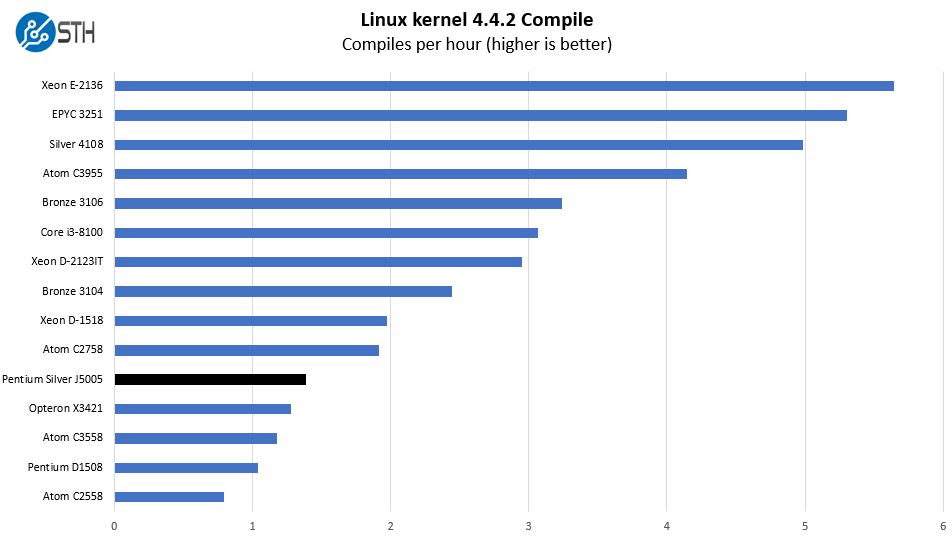
Here we can see solid performance just above what the quad-core Intel Atom C3558. The Intel Atom C3558 suffers from a maximum clock speed of 2.2GHz in comparison to the maximum clock on the Intel Pentium Silver J5005 of 2.8GHz on the Fujitsu D3544-S3.
c-ray 1.1 Performance
We have been using c-ray for our performance testing for years now. It is a ray tracing benchmark that is extremely popular to show differences in processors under multi-threaded workloads. We are going to use our 4K results which work well at this end of the performance spectrum.
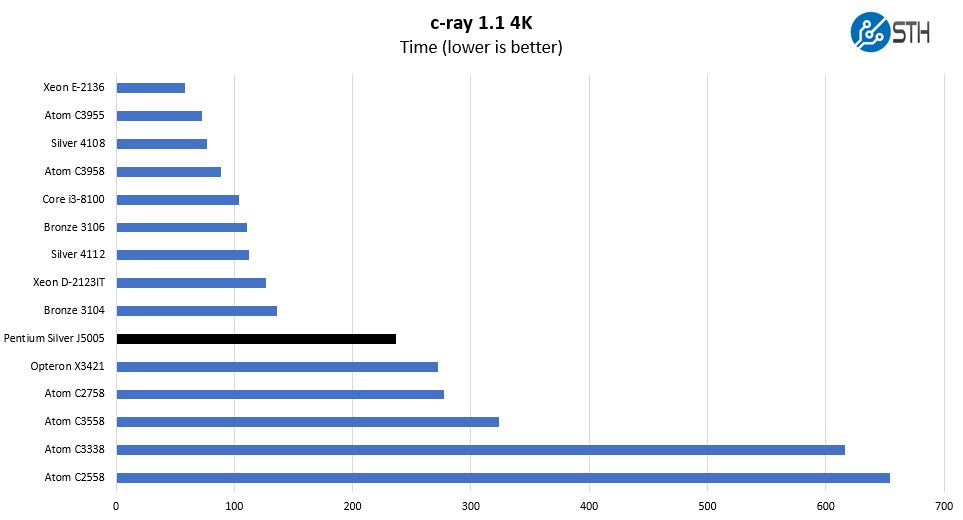
Here you can see that the four core Intel Pentium Silver J5005 performs well against the eight core Intel Atom C2758. That shows just how much advancement the Intel Atom team is making. At the same time, the jump to higher performance goes well beyond a 10W TDP and passive cooling that we get with the Fujitsu D3544-S3.
7-zip Compression Performance
7-zip is a widely used compression/ decompression program that works cross-platform. We started using the program during our early days with Windows testing. It is now part of Linux-Bench.
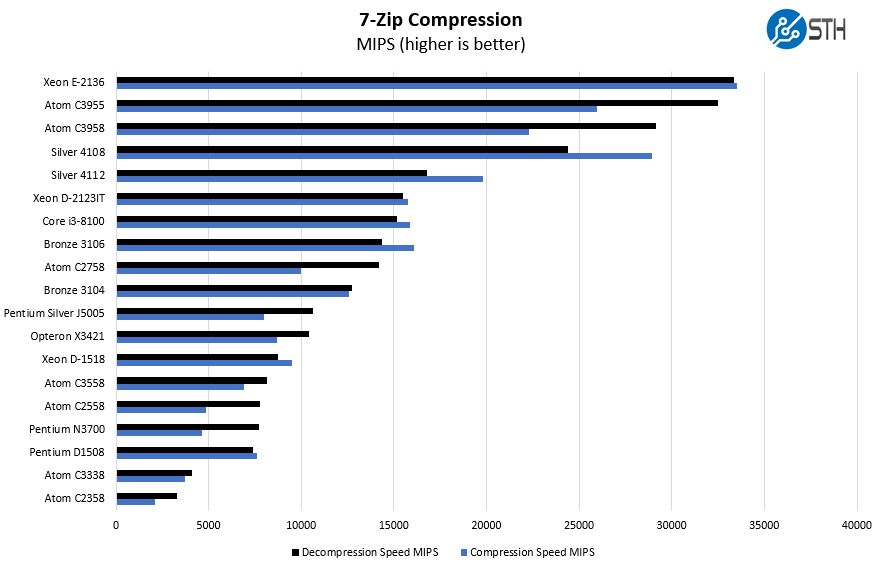
Here we have some absolutely great performance. We wanted to point out that the performance is about on par with the AMD Opteron X3421 in this case and many others. That AMD part, popular in the HPE ProLiant MicroServer Gen10, is a 35W TDP part and the Fujitsu D3544-S3 edge server is providing a similar performance level without using a fan and in a smaller physical footprint.
Sysbench CPU test
Sysbench is another one of those widely used Linux benchmarks. We specifically are using the CPU test, not the OLTP test that we use for some storage testing.
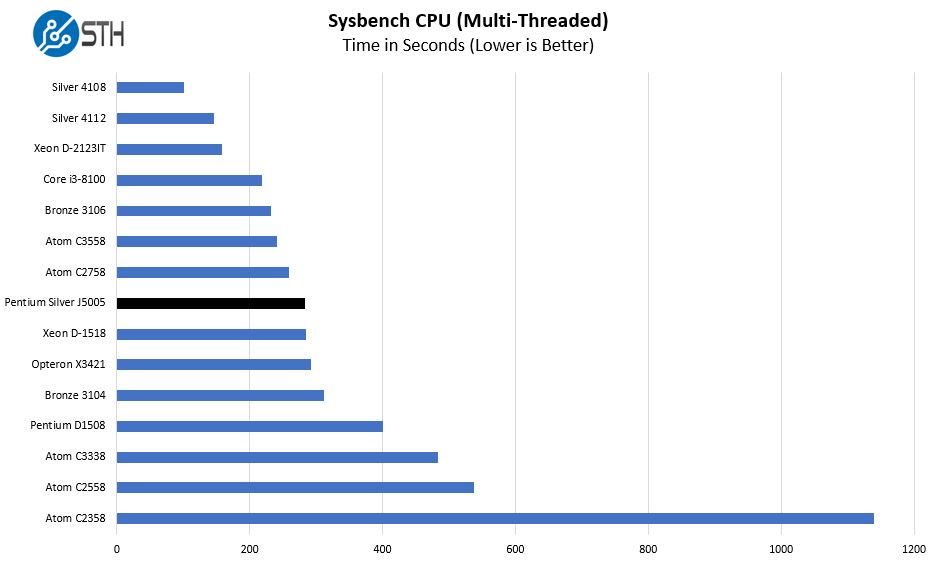
This is another great result which is helped by the benchmark size and the higher clock speed of the Intel Pentium J5005 found on the Fujitsu D3544-S3.
OpenSSL Performance
OpenSSL is widely used to secure communications between servers. This is an important protocol in many server stacks. We first look at our sign tests:
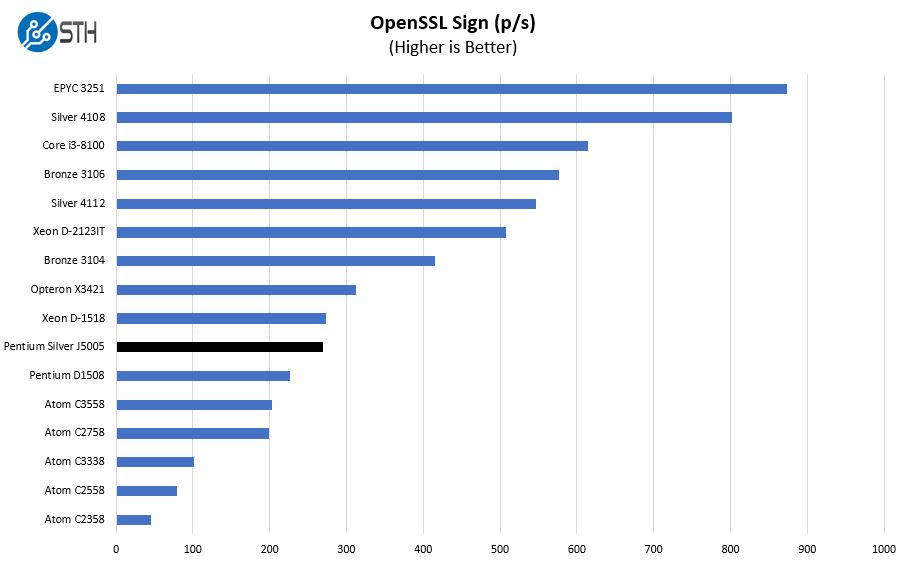
And the verify results:
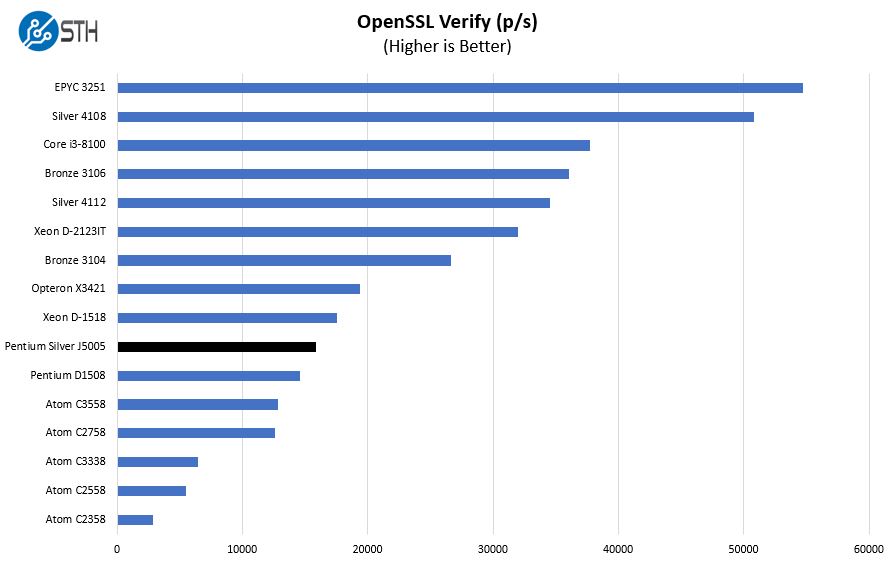
Here the SoC choice for the Fujitsu D3544-S means that it can be used as a server for a large number of hosting duties, whether that is for a kiosk or even as a low power public or internal web server.
UnixBench Dhrystone 2 and Whetstone Benchmarks
Some of the longest-running tests at STH are the venerable UnixBench 5.1.3 Dhrystone 2 and Whetstone results. They are certainly aging, however, we constantly get requests for them, and many angry notes when we leave them out. UnixBench is widely used so we are including it in this data set. Here are the Dhrystone 2 results:
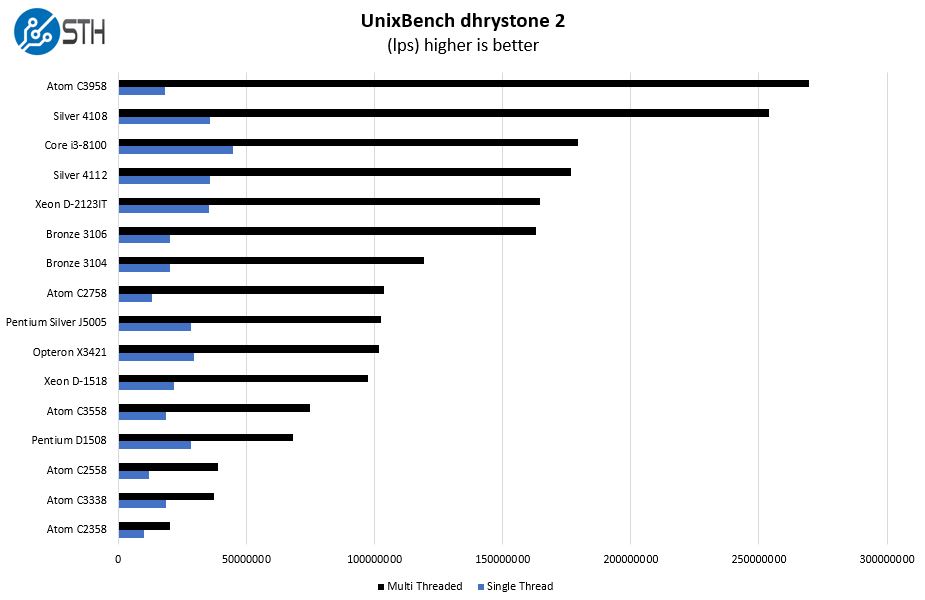
Here are the whetstone numbers:
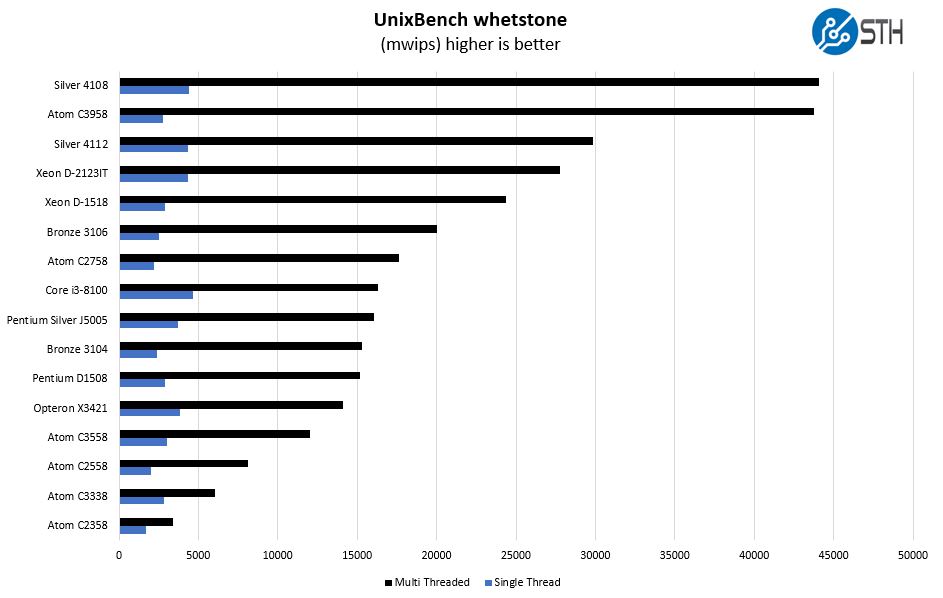
Overall, these are good results. We see performance just above the AMD Opteron X3421 which is a welcome result. That puts this Fujitsu D3544-S part above the HPE ProLiant MicroServer Gen10 in terms of performance. If you wanted a lower power machine that has dual 4K outputs, the Fujitsu D3544-S is able to keep pace with the CPU performance of the HPE at a lower cost, lower power consumption, and while being completely silent in operation.
Chess Benchmarking
Chess is an interesting use case since it has almost unlimited complexity. Over the years, we have received a number of requests to bring back chess benchmarking. We have been profiling systems and are ready to start sharing results:
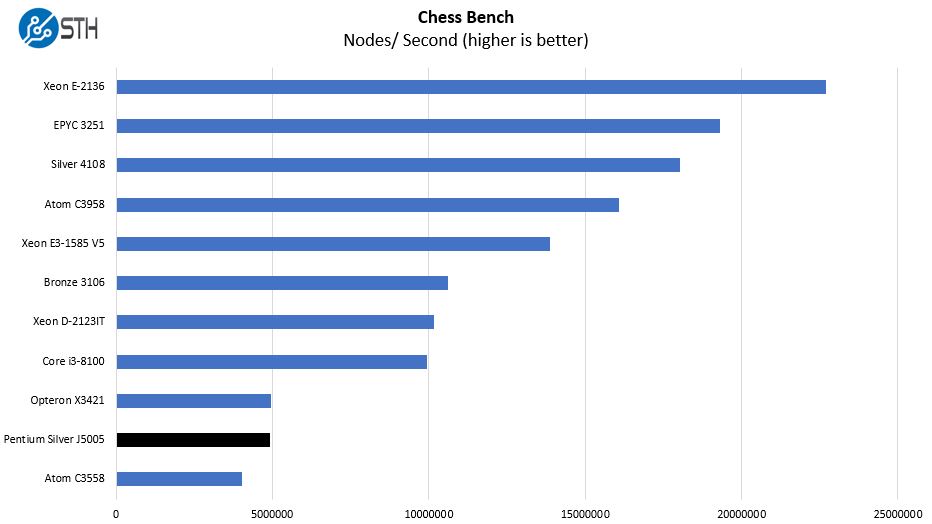
Here we wanted to point out that as good as the Intel Pentium Silver J5005 is, the $161 price tag is steep. Large companies like Fujitsu can get significant discounts when making products like the D3544-S.
Next, we are going to have the power consumption and our final words.




I note 2 SATA headers on the MB, are there power connectors/headers also provided
Pity that it does not support ECC RAM. IMHO for majority of industrial usage, this is a must have feature. Otherwise board looks fantastic.
“First, we would prefer two Intel i210 NICs instead of a Realtek plus an Intel. That would open the door to a wide range of applications.”
You could say that again. With a pair of intel nics this could be a great candidate for smb pfsense box.
Also curious on OpenSSL testing – is AES-NI is used by default?
I do not like the growing reliance starting about 10 years ago by manufactures and for the sake of “cost reduction engineering” to remove the physical hard switch for completely turning off the power to a device, low voltage or not, thus not unplugging a live source to perform the task of full electrical power shut down.
I learned from intense formal education in US Navy schools to decades of hands on mentoring by those many years my senior (knowing well from practice what is improper and why), to myself being a former instructor for Basic Electricity and Electronics, to having years of experience with integrated applications where access is not practical, such that the user method of physically unplugging a device as a means to turning off the power, is not a good electrical engineering practice. Most receptacles that are for low voltage DC are not designed with the intent to be used as the principle means to turn on and off a device. That is why even though low power DC and AC, external power supplies with generic use certifications have been packaged for many decades to avoid having to test a high voltage (110AC) circuit and related power supply for newly designed low power appliance, had a hard switch, not just a momentary, state change, switch.
Why the aren’t any numbers in the benchmarks?! This isn’t serious because I can’t compare them to my current machines… Please fix this.
@Peter K,
It does mention in the article that they don’t provide all the data that they collect because they also provide consultancy and testing services. We don’t pay for STH so they can provide whatever they like, if it’s business critical for you to know the numbers then you could always contact STH and get them?
I think Fujitsu D3433-S2 Industrial Mini ITX with Kabby Lake is more flexible:
1. 3x nvme with x8 riser or maybe 5x nvme with x16 riser
2. 1080p gaming rig with 17-21w idle on w10 desktop with Quadro P1000+1x nvme+2x5Tb slim hdd+wifi.
3. Opnsense box with x16 riser+ mellanox 4 100GBE
@Laugh|nGMan You are comparing apples to oranges. The J5005 is embedded and has 6 PCIE 2.0 lanes. The Q170 chipset has 20 PCIE 3.0 lanes, of course its going to be more flexible.
As with the sketchier very small format devices available from direct from China vendors like Qotom, the lack of a second DIMM slot is a disappointment, as these SoCs all support Dual Channel RAM — a lot of that bus bandwidth and multicore capability is wasted when you can’t use it. It should also be noted that the Qotom and similar routinely include a pair of Intel i211 NICs in a passively cooled case and heat is not a problem. Intel i-series NICs aren’t remotely the kind of fireballs they were in the pro/1000 era when you absolutely had to have air moving over them.
Sort of surprised there is no HDMI option for flexibility.
Re: https://www.servethehome.com/fujitsu-d3544-s-review-an-industrial-mini-stx-platform/4/#comment-464076
@Park McGraw I completely agree with you. I believe that this is the sort of thing that is used a cost-cutting measure. The absence of real power switches on electrical devices these days is worrying, and I think this is a good prompt for me to further improve my soldering skills.